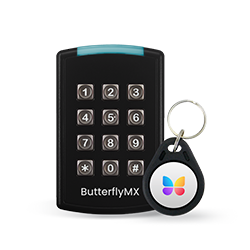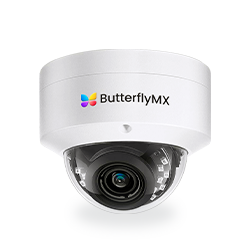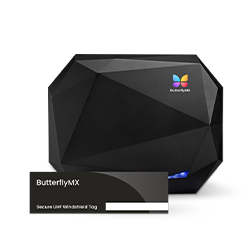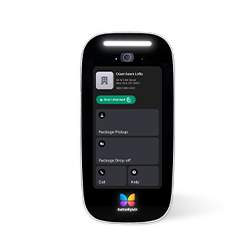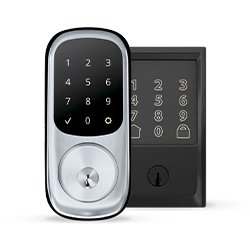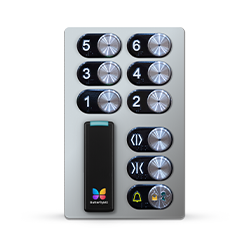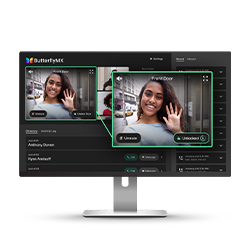Key takeaways
- A cellular telephone entry system empowers residents to use their cell phones to communicate with visitors and grant property access to guests.
- Cell phone entry systems use cellular networks to establish contact between guests and visitors.
- Cellular entry systems are limited by their cost, inconvenience, often lack of cameras, limited property access options, and lack of cloud-based technology.
- WiFi phone entry systems and video intercoms are alternatives to cell phone entry systems.

Whether you manage a gated community or own an apartment building, the entry system you install affects how visitors, delivery carriers, and even residents access your property. You might consider a cellular telephone entry system if you’re seeking a wireless access control system for your gate or door.
Although telephone entry systems have historically required landlines, some systems now operate over cellular connections. Read this post for a quick guide to the three best cellular telephone entry systems, and find out if a cell phone entry system is the right solution to meet your property access needs.
This post covers:
More than 40K, 5-star reviews!
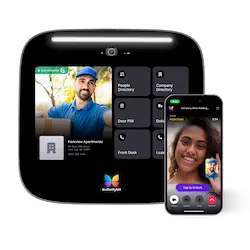
Video Intercoms
Open doors, gates & garages from anywhere.
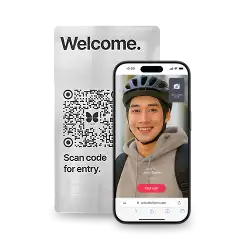
QR Code Intercom
Smartphone-based visitor access.
Access Control
Fob, key cards, PINs, and mobile apps.
Security Cameras
Visibility throughout your property.
Vehicle Access
Hands-free access for gates & garages.
Package Room
Receive, store, and manage deliveries.
Smart Locks
Connect to all major brands and models.
Elevator Controls
Unlock key-fobbed elevators for anyone.
Front Desk Station
See all your doors and cameras in one place.
3 best cellular telephone entry systems
Looking to transform how you manage access in residential, commercial, and industrial spaces?
Here’s our picks of the best cellular telephone entry systems:
1. ButterflyMX
Cell phone entry systems often lack the robust features and functionality of video intercoms. So, if you’re looking for a better multi-tenant intercom system, choose a video intercom like ButterflyMX instead.
Installed in more than 15,000 buildings, ButterflyMX is the industry’s leading property access solution.
Here’s what makes ButterflyMX better than a typical cellular entry system:
- Top-rated mobile app. Control your gate from anywhere with the top-rated ButterflyMX mobile app.
- Unified access control solution. Enable seamless property-wide access with a unified access control solution to manage access at doors, gates, and elevators.
- 156-degree wide-angle camera. This camera guarantees enhanced security by ensuring you see all entry activity without blind spots.
- Vandal-resistant. The ultra-durable ButterflyMX intercom is tamperproof and weather-resistant.
- RFID or WiFi connectivity. Flexible connectivity options empower tenants to open access points with a smartphone, PIN code, or key fob.
- Visitor Passes. Share temporary access codes with visitors and service providers that automatically deactivate after an allotted period of time.
- Delivery passes. Streamline deliveries for parcel and UberEats couriers by granting them secure access to your property.
- Elevator controls. Control and restrict access to certain floors with your key-fobbed elevator.
- Keypads. Manage access to shared amenity spaces, server rooms, and more with the ButterflyMX keypad.
Discover how ButterflyMX works:
2. Cellgate
Cellgate offers trusted telephone gate entry solutions for all industries, from single-family homes to farms and ranches.
What to expect from Cellgate:
- Convenient text notifications. Receive text notifications every time someone enters or leaves your property.
- Easy gate control. Open or close your gate on command with an app or web portal.
- Set up hold open schedules. If your property is undergoing maintenance, set up “hold open” schedules for service trucks and providers.
- Can be solar-powered. Cellgate Watchman systems are powered by solar or AC power for a more energy-efficient alternative.
- Prop-open alerts. Receive alerts if your gate is left open for an extended period.
3. Amazing Gates
From swing to sliding gates, Amazing Gates specializes in heavy-duty gates for commercial and residential properties. Their Ascent C1 – AAS cellular-based telephone intercom systems enable convenient gate control via app, text, or voice controls.
Amazing Gates offers features like:
- Accommodates thousands of users. Enable seamless access for up to 10,000 users.
- Audit trail. Access detailed user entry reports with convenient visitor logs.
- Versatile modes. The Ascent model and other advanced latch modes offer a “Do Not Disturb” mode.
- Control your gate from anywhere. Enable remote access with a computer, tablet, or smartphone.
- Simple to install. Easy to mount on any electric gate.
- Weather-resistant. Durable enough to withstand extreme weather conditions.
What is a cellular telephone entry system?
A cellular telephone entry system is a multi-tenant intercom that allows residents to use their cell phones to communicate with visitors and grant property access to guests.
Cellular entry systems improve upon traditional telephone entry systems by using cellular networks instead of physical landlines. Many cellular telephone entry systems are modified landline entry systems.
Landline and cellular telephone entry systems function in the same way. At their core, they are designed to enable a tenant to grant property access to their visitor. The difference between the two systems is their connection: one is based upon cellular signals, and the other occurs via a landline.
Let’s review some intercom terminology to help us fully understand the differences between cellular entry systems and landline entry systems.
All phone entry systems have two parts:
- A base station is the hardware installed at an entry door or gate that visitors use to contact residents.
- A substation is installed in residents’ apartments. It lets residents speak with guests and grants property access. A substation can be a piece of hardware with a microphone and speaker, a landline phone, or—most recently—a cell phone.
What is the difference between a cellular telephone entry system and a landline entry system?
Traditional landline telephone entry systems connect the system via a wired landline. In contrast, cellular entry systems connect via a cellular connection, much like what your cell phone uses to make calls.
Landline entry systems require you to purchase and run a phone line to the base station installed at the entryway of your building. Now, cell phone entry systems have eliminated the need for telephone wiring. This lack of wiring also makes setting up an outdoor gate access system easier, as you’ll no longer need to run wiring from your building to your gate.
How landline systems became cellular systems
Cellular telephone entry systems were developed during the shift from landline phones to cell phones.
Before they used cellular networks, residential telephone entry systems used copper wires to connect an entryway’s door station to each resident’s apartment. Installing one of these entry systems meant modifying existing phone lines or purchasing and laying new wiring.
Even today, running wire throughout a building means tearing out walls and rebuilding them again, and those costs add up. Moreover, residents could only answer calls from guests when they were in their homes. As a result, landline phone entry systems caused residents to miss visitors and deliveries.
When cell phone popularity exploded in the 2000s, the landline system quickly became outdated. Intercom providers turned to cellular technology as a better, more efficient alternative to wired landlines. In contrast to landline systems, cell phone-based systems use cellular networks, eliminating the need for wiring.
How does a cellular telephone entry system work?
Cellular telephone entry systems use cellular networks to establish contact between guests and visitors, similar to wireless telephone entry systems.
These calls allow residents to speak to whoever is at the base station and grant guests access. Since the system is cell phone-based, residents don’t have to be home to let their guests onto the property.
Here’s how a cell phone entry system works:
- A guest seeking property access finds the resident they’re visiting in the entry system’s base station.
- The telephone entry system places a call over a cellular network to the resident’s phone.
- When the resident picks up, they can speak with the guest like any other phone call. Their guest can hear and speak with them, too, since the system’s base station has a microphone and speaker.
- Finally, the resident can let the guest in by pressing ‘9’ on their cell phone.
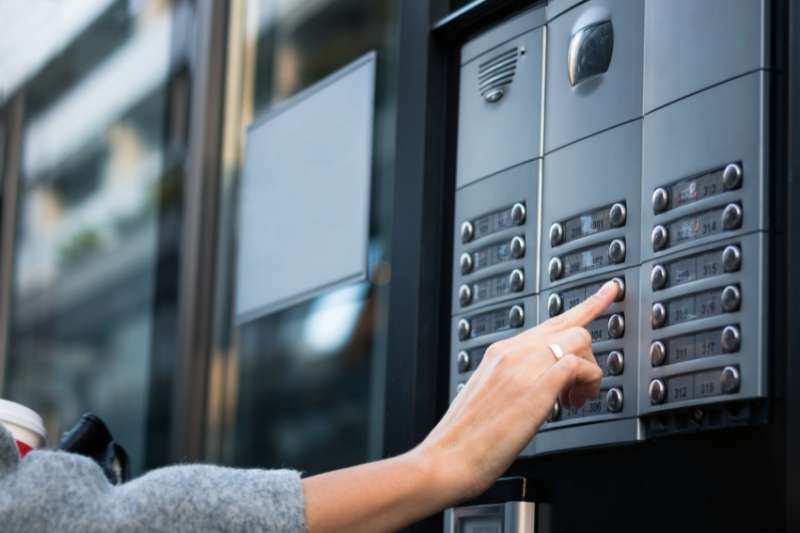
Cell phone entry system limitations
Cellular entry systems are more convenient than landline systems. However, they do not offer all the features that today’s residents expect from a modern building entry system.
Here are some limitations of cell phone entry systems:
- Expensive. Using a cellular network for calls may require investing in a commercial-grade cell phone plan with an ongoing, high-bandwidth connection.
- Inconvenient for you. Who’s going to be stuck with scheduling and managing a technician whenever a resident moves in or out? Those aren’t tasks you need to add to your busy schedule. So, it’s best to look for a system that automatically updates rent rolls, taking things off your plate instead of piling on.
- Lacking video. Cellular entry systems don’t offer video functionality. That means residents can’t video chat with visitors and visually confirm who’s requesting property access.
- Few property access methods. When a visitor arrives at a building with a cell phone entry system, their only option is to call the resident. There are no Visitor Passes for guests or delivery PINs for couriers.
- No cloud-based management. Cloud-based entry systems let property staff manage access and update the tenant directory from anywhere, on any device, with a web-based dashboard. In contrast, cellular entry systems require you to download software onto one specific device to manage the system remotely.
Alternatives to cellular telephone entry systems
As the smartphone gets smarter, cellular entry systems are becoming obsolete. They’re harder to install and offer fewer features than the latest property access solutions. But there’s good news: You have better options.
Three possible alternatives to cell phone entry systems include:
Telephone entry systems with cameras
To accommodate technological innovations, some manufacturers have opted to offer a telephone entry system with a camera. These systems may have a built-in camera or require you to purchase and install a camera separately.
However, telephone-based intercoms don’t have the bandwidth to handle two-way video transfers. As a result, residents can see a live feed of their visitors, but visitors can’t see residents.
WiFi telephone entry systems
In recent years, some companies have attempted to modernize the telephone entry system using WiFi instead of cellular networks. WiFi telephone entry systems send data between residents’ cell phones and system hardware via WiFi instead of a telephone network.
WiFi telephone entry systems are a decent attempt at adapting cellular systems to the modern age. However, they fall short in crucial ways. WiFi networks and phone networks are different, so consistent and rapid communication between them is difficult.
Cell phones, especially smartphones, can easily interpret data from WiFi networks. But cellular entry systems can’t. Since cell phone systems can only handle certain kinds of data, adding WiFi capabilities to a telephone entry system is difficult.
Video intercom systems
Video intercoms are the best alternative to a cellular telephone entry system. Like cellular entry systems, smart video intercoms use phones as intercom substations for communication and guest entry. But unlike cellular entry systems, video intercoms are capable of more than just phone calls.
The best video intercoms for apartments are wireless, fully smartphone-compatible, and leverage the full power of the smartphone for a seamless property access experience.
Video intercoms let residents use their smartphones to video chat with visitors and open doors and gates remotely. They also offer other property access methods, which means visitors have more than one way to request access. The best systems may offer Visitor Passes for planned visits and delivery PINs and passes for courier access.
Pro tip: When shopping for a video intercom, choose a cloud-based system to manage access and update your tenant directory remotely.
Video intercoms vs. cellular telephone entry systems
Today’s video intercoms give property managers and residents the power to manage access simply. Smartphone gate entry systems and other video intercoms use the latest technology to make administration easier for property owners and managers while simplifying property access for residents and guests.
Tenants will surely appreciate a residential gate access control system that doesn’t make them walk outside to see who’s visiting. For property staff, video intercoms offer features like web-based dashboards that display an audit trail of door releases and enable remote management.
Here’s a comparison between smart video intercoms and cellular telephone entry systems:

Get your free quote!
Fill in the form below, and we'll email you right back.
Want a free quote?
Fill in the form below, and we'll email you right back.
You’ll be redirected shortly...






